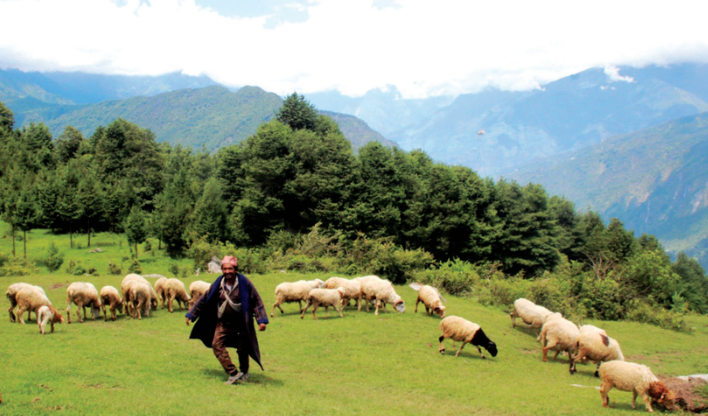Understanding the relationship between needs, emotions, and actions
Some of the biggest challenges we experience as humans are identifying our emotions, understanding them, and expressing them to facilitate understanding and cooperation. To overcome these challenges, Emotional Literacy (the ability to identify, understand, label, and express emotions positively) can help us. It leads to increased self-awareness (being clear about what we need in a given moment and directing our behavior or making choices accordingly) and increased empathy (connecting with the feelings and needs of other people to get to know and understand them better). It can also help develop empathic communication skills (listening for the needs in what others share and communicating our needs to reduce conflicts, miscommunication, and misunderstandings). How do we get started on developing better Emotional Literacy? Understanding three principles can help in this regard. Principle #1: At any moment, we are trying to meet universal, all-inclusive needs (like physical safety, emotional support, respect, peace, learning, contribution, etc.). What to unlearn: We usually think that having or expressing needs is an act of selfishness. When someone vocalizes their needs, we call them needy, clingy, and self-obsessed. What to learn instead: The truth is that we all have needs. More often than not, we are unaware of our needs. Even if we are, we don’t know how to express those needs without unpleasantly impacting the listener. Principle #2: Our emotions (such as anger, disgust, joy, calmness, frustration, relief, etc.) hint at our met and unmet needs. What to unlearn: We usually think that some emotions are ‘good’, such as trust, surprise, and happiness, while we label anger, sadness, disgust, and fear as supposedly ‘bad’ emotions. When we see our emotions as good or bad, we tend to chase pleasant emotions and run away from unpleasant ones. It is also what we call ‘toxic positivity.’ What to learn instead: To become emotionally literate is to understand that emotions may be unpleasant and pleasant. They are not good or bad because they send us signals about our met and unmet needs. Once we understand this principle that governs our emotional well-being, we become aware of what needs cause our pleasant feelings and what unmet needs cause unpleasant feelings so we can eventually handle our unpleasant feelings well. Principle #3: Everything we do with our actions or inactions (using our body) is an attempt to meet our underlying needs (for example, talking, remaining silent, eating, running, etc.). What to unlearn: “This person loves making my life a living hell!” “I know they did that to see me in pain!” We often make assumptions like these when the actions of people around us are unhelpful in fulfilling our needs. What to learn instead: Someone’s actions or inactions are their ways to primarily meet their needs and not make our lives difficult. Understanding this means seeing things as they are and not making false assumptions and stories. As a result, we become more empathic and focus on fostering mutual understanding instead of blaming, complaining, and judging people for being unhelpful, ignorant, or troublesome. Here are a few examples to understand the three principles better. You value/need communication and closeness with your friends. You call them up, but no one answers. Due to your unmet needs, you end up feeling sad. You are struggling with a project at work, so you need support and consideration. You reach out to a colleague for help, and he/she provides you with guidance and support for which you feel thankful. You value/need efficiency, so you try to ensure that you follow a routine to submit your assignment on time. The internet goes off right when you’re about to submit your work, and you start panicking because you might miss the deadline. You value/need physical safety. You feel safe and relieved when you see other people around you wearing a mask so that you don’t contract the virus from one another. You value/need peace and harmony, so when an elder in the family talks to you loudly, you feel fearful and disgusted. All these examples point to three things—at any given moment, we have one or more needs, our needs cause us to experience certain emotions, and to fulfill our needs, we either rely on some actions or inactions (using our bodies). Do these principles make sense to you? Think of a recent activity you did. Would you agree that you were trying to meet one or more of your needs through that action? Did you feel pleasant or unpleasant based on whether your actions/inactions helped you meet your needs? None of the emotions are good or bad. They are signals of our universal needs, which we try to fulfill through actions or inactions. Those actions can prove to be either healthy or unhealthy in due course of time, but emotions are not good or bad in and of themselves. The clearer we are in navigating the cyclic relationship between needs, emotions, and actions, the more we can connect with ourselves and others. The author is the Linchpin at My Emotions Matter, an education initiative that helps individuals and teams learn the mindset and skills of Emotional Intelligence. You can learn more at myemotionsmatter.com
Earthquake destroys three houses in Bajhang and Bajura
Three houses were destroyed in the earthquake in Bajhang and Bajura on Tuesday.
Two houses were destroyed in Badimalika Rural Municipality of Bajura.
DSP Surya Thapa said that the houses of Harka Gurung and Harichand Padhyay were destroyed in the earthquake.
He said that there were no human casualties.
DSP Thapa said that police have not been able to contact the locals of Bichchaya, the epicenter of the earthquake.
The snowfall coupled with rain has disrupted electricity and telephone service in Bajura since this morning.
 Likewise, the earthquake also destroyed a building in Bajhang. The Armed Police Force had been using that building.
An earthquake measuring 5.9 on the Richter scale hit Bajura district at 2:43 pm today, National Earthquake Monitoring and Research Centre said.
Likewise, the earthquake also destroyed a building in Bajhang. The Armed Police Force had been using that building.
An earthquake measuring 5.9 on the Richter scale hit Bajura district at 2:43 pm today, National Earthquake Monitoring and Research Centre said.
Youth attempts self-immolation in New Baneshwor
A youth attempted self-immolation in New Baneshwor on Tuesday. Prem Acharya of Panchakanya, Ilam set himself on fire and attempted suicide this afternoon, Kathmandu District Police Range spokesperson Dinesh Raj Mainali said. Mainali said that he was rescued immediately and rushed to the Burn Hospital in Kirtipur. He said that they are looking into the case.
Lakshmi Ghimire: A powerful presence in province assembly
Images of a woman in a wheelchair entering the legislature anywhere in the world send a powerful message to the public. Lakshmi Ghimire, a lawmaker in the 110-strong Bagmati Province Assembly, symbolizes it all. The 28-year-old is the first lawmaker in the legislative assembly to represent people with disabilities. Although the Constitution guarantees equal rights for women, indigenous nationalities, people with disabilities and other marginalized groups, the provision remains on paper for many. Ghimire is the first person to get elected to the assembly on a disability quota. The young parliamentarian hails from Sanga in Kavrepalanchowk district. She joined the Sajha Party in 2017. Recognizing her contributions, the party sent her to the Bagmati Province Assembly under the proportional representation (PR) system. The youngest among five sisters and a brother, Ghimire was paralyzed from the waist down after falling off a cliff when she was just 16. "I had just joined Grade 11 after completing my SLC at the time of the accident. I fell off a cliff while collecting fodder during Dashain vacation," she said. A year-long stay at hospital further hindered her studies. "Given the lack of disabled-friendly infrastructure, it wasn't possible to attend school in my village," Ghimire recalled. Overcoming these challenges, she pursued her education and moved to Kathmandu, where she stayed at a rehabilitation center in Sanga (Bhaktapur). Later, she started taking computer classes, which motivated her to give continuity to her studies. She then re-enrolled in Grade 11 at Jorpati-based Chamunda Secondary School and earned a degree. Participating in the activities of different organizations working in the disability sector, Ghimire felt a “strong desire to do something for the people with disabilities”. She joined the RPP and got involved in its activities. "I worked full-time for the party. Recognizing my contributions, the party included me in the proportional representation (PR) system. I didn't get this opportunity just because of my disability." So, how was her first day in the assembly like? It was not so pleasant due to the lack of accessible infrastructure. She struggled during the swearing-in ceremony. "Though aware of my disability, the province assembly secretariat did not make necessary arrangements. I was disappointed," she said. Having reached the policymaking level, what does the young lawmaker plan to do, first and foremost. She says she is determined to make infrastructure more accessible for people with disabilities. She believes all government offices within the province and affiliated organizations should have a universal design that is friendly for everyone, including people with disabilities, senior citizens and children. Ghimire, having seen such designs in countries like India and South Korea, notes that these countries already have disability-friendly infrastructure, built with the thought that everyone should have equal rights, not only in public but also in private places, from motor vehicles to structures. “Like other people, we have paid the same amount of tax to the state,” said Ghimire. “Therefore, people with disabilities should get the same service and facilities as them, and should be able to live comfortably.” She believes that the state should create an environment where people with disabilities can live like others. There’s a need to raise awareness and put pressure on other provinces to follow suit, she says. “The state should also work to create a more inclusive and accessible society for people with disabilities. That way, they can enjoy the same rights and opportunities as others.” Her prescription: provide concessional loans to people with disabilities to help them start their own businesses. Ghimire hopes to become the voice of disabled people across the country by reaching the federal parliament in the next term. "I am not in an executive position now, but I will definitely do some exemplary work if I get to that position." Ghimire mentions that even though she faced small problems due to her disability, she did not experience any major discrimination. "Maybe because I had the support of my family, I didn't have to suffer discrimination." Remembering the difficult time when she had to stay in the hospital for a year after her accident, Ghimire said she had almost given up on her life as an invalid. "But everybody is proud of me now. They say I have been able to do good for society despite my condition. This gives me a lot of encouragement," she said. Ghimire used to believe that good education should be the top priority for people with disabilities, but she has come to believe now that building accessible infrastructure should be the first priority. Nepal lacks accurate data on the number of people with disabilities, though estimates suggest there are 800,000 to 1 million people with disabilities in the country, about 200,000 of them with spinal cord injuries like Ghimire.



















